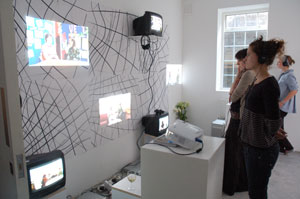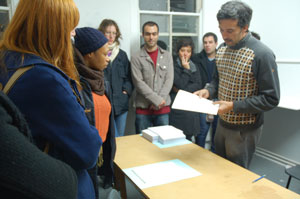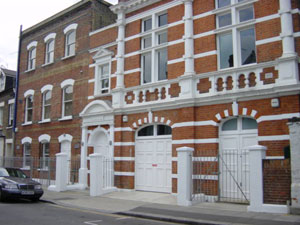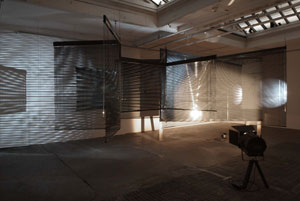The impact of the 2008 – 2009 financial crisis is undoubtedly a global phenomenon, but there are some cities, such as London — once the world’s leader in all financial sectors except hedge funds — that have been hit a little harder. Simultaneously, Gordon Brown’s arts and culture supporting Labour Party is struggling in the wake of an embarrassing expenses scandal and shaky leadership. Although they are continuing to put their best foot forward, young London gallerists Alison Jacques, Stuart Shave and Pilar Corrias recently dove into overheated real estate in Central London, only to see property values in their posh new postcode rapidly drop. In the spring of 2009, when I visited London’s commercial spaces, many gallerists were quoting drops in sales of up to 80%. One dealer predicted that half of London’s commercial galleries will be gone within a year. Although he may have been overstating the direness of the situation, London’s commercial galleries (those forced to close, and those still pushing forward) have felt a significant impact of the financial crisis in the past 12 months. According to Art Market Research, in 2009 contemporary art prices dropped 63%. (In the two years preceding September 2008, the same research group reported that prices of contemporary art had unnaturally ballooned 313%.) The current crash (or rather, adjustment, as it seems) looks to be more than necessary.
While not solely attributing it to the struggling commercial market, in the December 2008 issue of Artforum, Londoner Emily Pethick outlined a certain shift in the city’s contemporary art scene towards independent initiatives — artist-run spaces and residency programs. Mark Sladen and Richard Birkett’s Nought to Sixty at the Institute of Contemporary Art might be the first example of a public space catching on to this trend — presenting a series of week-long solo projects by artists (most under the age of 35) from all over the UK.
Although the current economic environment requires a more creative approach to the presentation of contemporary art, there is also a real advantage to the diversification of modes of production and exhibition, in that new channels of exchange are being opened and explored. London has always been geographically and culturally positioned as a bridge between the US and continental Europe. And it is at this moment of necessary evolution that London’s position as a site of exchange will be its greatest asset.
For artists who wish to leave the economic crisis in their home country for the economic crisis abroad, London offers some interesting and evolving opportunities.
International residencies, open to application
Gasworks in south London offers formal residencies to international artists through a series of programs aimed at artists from Hungary to India. Artists from Texas would do best to look into TrAIN, a three-month residency the London-based Research Centre for Transnational Art runs together with Gasworks, aimed at artists based anywhere outside of the UK. Applications for this residency are solicited by invitation only, and space in Gasworks general residency program are currently unavailable through general expressions of interest. Three of the 12 studios at Gasworks are available for international residents, while the remaining space is used by London-based artists. Resident artists are also encouraged to present their work with an informal evening of talks at the Gasworks space, and each residency culminates in a weekend of Open Studios, frequented by local and visiting curators and artists.
Applications for the Cartier Award, a prize granted in association with Gasworks and Frieze projects, are accepted annually between October and January. Like the 2009 Cartier Award recipient, Jordan Wolfson, winners are emerging artists living outside of the UK. The application for the Cartier Award should take the form of a project to be produced at the Frieze Art Fair, with winners earning a residency at Gasworks, a modest artist’s fee and a significant production budget — not to mention the benefits of the publicity generated by the international fair.
International residencies, by invitation only
The private not-for-profit space westlondonprojects was initiated by collectors Maddalena and Paolo Kind with the goal of giving emerging international artists a dynamic venue in the UK. Curator Christiane Schneider runs the program at westlondonprojects, organizing exhibitions and inviting artists to work at the space and produce a show at the end of their residency. “With westlondonprojects,” Schneider says, she “would like to create a kind of niche where artists can work a bit more openly and playfully than they might sometimes be able to when they do exhibitions in institutional or commercial spaces.” However, the residency is not open to applications; usually Schneider approaches artists she is interested in after she has followed their work for a while.
Mega-collector Anita Zabludowicz’s private non-for-profit space Project Space176, in North London, hosted an artist in residence when the space was launched in the fall of 2007. Rina Banerjee produced a site-specific work for the debut exhibition, An Archaeology, and for Zabludowicz’s collection. As of now, Banerjee is the only artist to have completed a residency at 176, but the space (a former church), and the money behind the project (Zabludowicz’s husband, Chaim “Poju”, is an international arms dealer — a field that doesn’t currently seem to be suffering the impacts of the financial crisis) seem to be capable of supporting an ongoing program. Watch this space.
Independent spaces
FormContent, a curatorial platform initiated by Francesco Pedraglio, Caterina Riva and Pieternal Vermoortel in 2007, runs a program of collaborative projects in their new space above the Ridley Road food market in East End. Also co-editor of the new Kaleidoscope magazine (a free publication launched in March 2009 by former Mousse magazine publisher Alessio Ascari), Pedraglio told me that although the space typically develops its own shows, they can also be open to curator’s proposals — although not to proposals of solo shows.
Although not open to applications from artists from the US, Cubitt, The Showroom and Studio Voltaire are three of London’s most important independent spaces — providing studio and exhibition space to British and international artists — and are a must see for visiting curators. Cubitt opened its doors in 1991, providing studio and exhibition space outside of London’s commercial gallery scene. Since 2001, Cubitt has received funding from Arts Council England and now employs a curator, education coordinator and manager, expanding the scope of its exhibition program while remaining independent and decidedly non-commercial. In September 2009, on the occasion of its 25th anniversary, The Showroom reopened at a new location in East London with an exhibition by the Otolith Group — continuing its goal to show underrepresented artists, often offering artists their first solo show. Studio Voltaire, a studio and gallery complex in South London, accepts applications from London-based artists for use of studio space, and runs two residency programs for artists from Scotland and Berlin. The initiative of these spaces, some of the first to seek the alternative of an artist-run or independent program, have set the groundwork for London’s current non-commercial contemporary art scene — a community that continues to develop despite, and perhaps because of, this current financial crisis.
![]()
Lillian Davies is a writer based in Paris, a regular
contributor to Artforum
and editor in chief of Uovo magazine.
Also by Lillian Davies:
{ The Ten List
}
The Ten List: The Unexpected at an Art Fair
Artist-Run Paris







